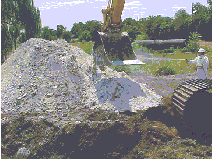

Maywood Project Site

 |
 |
Maywood Project Site |
|
 |
 U.S. Army Corps of Engineers
Moves Forward on Commercial Properties
U.S. Army Corps of Engineers
Moves Forward on Commercial Properties
View more photos of the Pre-Design Investigation Activities.
The RI will also include lab tests to determine whether and how far wastes could enter and travel through area groundwater under various conditions, and an analysis of potential health and ecological risks. The groundwater study is expected to be completed by spring 2001.
View more photos of the Groundwater Remedial Investigation (GWRI).
In September, 1999, USACE contractors provided radiological consulting support at New Jersey Department of Transportation (DOT) project sites on Route 17 and Essex Street in Lodi. Technicians measured radioactivity levels in soil during DOT excavations to locate underground utility lines. No radioactive contamination above the limits established to protect workers was found in the soil. The USACE contractors also advised site workers on appropriate protective clothing and other measures for safely working with potentially contaminated material.
Then in October, Borough of Maywood officials and USACE representatives met to discuss sediment that had accumulated in a drainage swale adjacent to a commercial property currently under study by the USACE (see figure opposite). The sediment was blocking storm water flow and contributing to persistent flooding in the area. The USACE has agreed to remove the FUSRAP waste in the sediment to prevent possible downstream migration into Lodi Brook and to restore flow to original design conditions. The USACE will implement this removal after completing a removal action work plan and coordinating with local, state, and federal agencies.
View more photos of Swale - Sediment removal
The long-term goal of the work at the interim storage site is to identify the soil that exceeds cleanup levels. This will ensure that only contaminated soil is shipped for costly offsite disposal. This effort could greatly reduce offsite disposal costs, while ensuring that protective cleanup standards are met.
View more photos of the Engineering Test Pit Activities
Return to list of Newsletters
 All of the work will be coordinated with property owners and tenants to limit impacts on normal business operations. As the fieldwork is completed, the scientific and engineering data collected will be evaluated. These findings, combined with information from earlier work, will be used in the next phases to evaluate appropriate cleanup methods (the Feasibility Study), select a preferred alternative (the Proposed Plan), and develop the engineering design for cleanup (the Remedial Design). The design will be completed after approval
of a Record of Decision (ROD) that will formally document the selected cleanup remedy for the site. Although release of the Feasibility Study and Proposed Plan was expected in 1999, additional study and coordination with agency partners has shifted the anticipated release date to 2000.
All of the work will be coordinated with property owners and tenants to limit impacts on normal business operations. As the fieldwork is completed, the scientific and engineering data collected will be evaluated. These findings, combined with information from earlier work, will be used in the next phases to evaluate appropriate cleanup methods (the Feasibility Study), select a preferred alternative (the Proposed Plan), and develop the engineering design for cleanup (the Remedial Design). The design will be completed after approval
of a Record of Decision (ROD) that will formally document the selected cleanup remedy for the site. Although release of the Feasibility Study and Proposed Plan was expected in 1999, additional study and coordination with agency partners has shifted the anticipated release date to 2000.

Groundwater Study Also Under Way
Another big step in the final cleanup of the Maywood site is the start of the groundwater Remedial Investigation (RI). Like the pre-design work, this investigation involves an in-depth field program to assess how and to what degree waste from the Maywood site is affecting groundwater. Fieldwork for the groundwater RI will include:

Army Corps Supports NJDOT and Borough of Maywood
A complex project like environmental restoration of the Maywood site demands a range of scientific, engineering and construction expertise. The USACE has such a team in place, and they are helping out right here in the community.


Engineering Tests Look to Reduce Waste Disposal Costs
Several excavations known as test pits were recently completed at the Maywood Interim Storage Site (see figure opposite) to help gain a better understanding of soil conditions there. Five test pits were dug in areas where historical drawings showed past disposal of thorium and other waste.
 The test pits were used to collect soil samples for analysis of radiological, chemical, and physical properties of the soil. This information will help scientists understand how radiological
contamination interacts with the known physical properties of the soil.
Using test pits offers an advantage over the more common investigative method of soil boring because it provides information on an entire cross section of subsurface soil conditions.
The test pits were used to collect soil samples for analysis of radiological, chemical, and physical properties of the soil. This information will help scientists understand how radiological
contamination interacts with the known physical properties of the soil.
Using test pits offers an advantage over the more common investigative method of soil boring because it provides information on an entire cross section of subsurface soil conditions.
